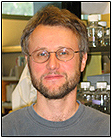Bio
 As an undergraduate, I studied Biochemistry at the University of Oxford, where I developed my enthusiasm for chromatin structure and gene regulation. I obtained my Ph.D. in 1987 from the University of Cambridge under the supervision of Professor Jean Thomas. My thesis work was aimed at understanding the structural role of histone H1 in chromatin. I moved to the United States to carry out postdoctoral work in Dr. Gary Felsenfeld's lab at the NIH. Initially, we investigated the effects of DNA supercoiling on nucleosome structure. Later, we addressed the problem of how RNA polymerase transcribes through a nucleosome.
As an undergraduate, I studied Biochemistry at the University of Oxford, where I developed my enthusiasm for chromatin structure and gene regulation. I obtained my Ph.D. in 1987 from the University of Cambridge under the supervision of Professor Jean Thomas. My thesis work was aimed at understanding the structural role of histone H1 in chromatin. I moved to the United States to carry out postdoctoral work in Dr. Gary Felsenfeld's lab at the NIH. Initially, we investigated the effects of DNA supercoiling on nucleosome structure. Later, we addressed the problem of how RNA polymerase transcribes through a nucleosome.
When I set up my own lab at the NIH, I decided to tackle the problem of how transcription is activated in the natural context of chromatin structure. Our studies have led me to believe that chromatin structure is designed to be an integral component of the activation process (as it is in gene repression); our current efforts are aimed at clarifying this role.
 BACK TO TOP
BACK TO TOP